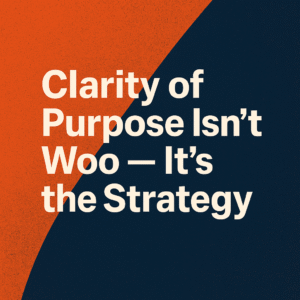
At some point in nearly every founder’s journey, there comes a moment when the pace blurs their priorities. They look up, eyes glassy, and think: “Everything feels urgent. I have no idea what actually matters right now.”
I know that moment well. It’s not a sign of failure — it’s a signal that the noise has taken over. And in the CPG world, where urgency masquerades as relevance and everyone has an opinion about what you should do next, it’s easy to get swept into the current.
But here’s the truth: clarity of purpose isn’t just some soft, fuzzy concept. It’s your anchor. Your strategy. Your decision-making filter when everything else feels like a storm.
Your “Why” Is the Most Underrated Strategic Asset
When I work with founders, we don’t start with revenue targets or hiring plans. We start with purpose. Why does your brand exist beyond the transaction? What are you here to prove, protect, or disrupt?
This isn’t performative mission statement fluff. Your purpose, when truly clarified, does three powerful things:
- It simplifies decisions. When you’re clear on what you’re building and why, you can more easily say no to opportunities that look shiny but don’t serve the mission. You stop chasing everything and start building something.
- It aligns your team. People don’t want to work for a company; they want to work for a cause. Purpose gives your team something to rally around, especially when things get hard. And they will get hard.
- It builds resilience. Clarity doesn’t remove uncertainty, but it changes your relationship with it. Founders who are anchored in purpose bend without breaking. They know what’s non-negotiable.
But My Investors Want Results
Of course they do. But here’s what often gets missed: a purpose-driven founder is more likely to drive consistent results because they’re not pivoting every five minutes. They build from conviction. They attract customers, team members, and partners who believe what they believe.
We’ve seen it time and again — brands that lead with clarity of purpose aren’t just more inspiring, they’re more effective. They waste less energy. They navigate trade-offs faster. They avoid the death spiral of “chasing the next.”
Purpose Isn’t a One-Time Exercise
If you clarified your mission three years ago in a deck and haven’t revisited it since, it’s likely stale. Just like strategy, purpose needs to evolve with you. That’s why I return to it often in my work, especially when founders are moving from one phase of the Tardigrade Roadmap to the next.
What felt urgent in Phase 1 (Clarity + Energy) is often irrelevant in Phase 3 (Legacy + Leverage). But what stays consistent — or gets even sharper — is the sense of why this matters.
I ask:
- What does “enough” look like now?
- What are you unwilling to compromise?
- What are you building that will outlast you?
This Isn’t Woo — It’s Work
Real clarity of purpose is earned. It doesn’t show up in a brainstorm or a company retreat. It’s uncovered over time, through messy conversations, conflicting priorities, and moments of deep discomfort.
It’s when you admit that the thing you’ve been grinding for might not be the thing you actually want.
It’s when you realize that scaling doesn’t mean selling your soul.
It’s when you commit to growing not because the market demands it, but because you have something worth growing.
That’s strategy. That’s leadership.
Clarity in the Face of Chaos
If you’re reading this and feeling the weight of a thousand to-dos, let this prompt you to pause.
Ask yourself:
- Why did I start this?
- What do I believe the world needs to hear, taste, experience, or feel?
- What am I building that’s bigger than me?
Don’t rush to answer. Sit with it. Let it simmer. Because when clarity returns, it brings direction. And direction is the antidote to overwhelm.
One Final Thought
Purpose isn’t an accessory. It’s the lens. The compass. The through-line.
In a world full of noise, founders who operate from a place of purpose, not panic, create the most enduring, meaningful brands.
And if that’s not strategic, I don’t know what is.

